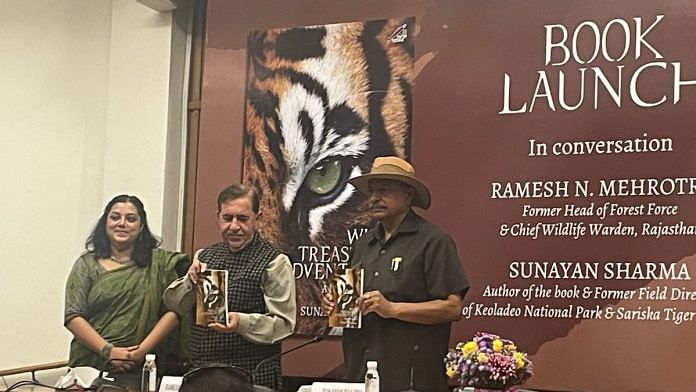New Delhi: The reality of the jungle is way more complex than what you see in the news. There is a world outside Connaught Place and Khan Market that people do not know about, said Sunayan Sharma, former field director of Keoladeo National Park and Sariska Tiger reserve to a group of wildlife lovers at New Delhi’s India International Centre.
Sharma, who was speaking at the launch of his book Wild Treasures and Adventures: A Forester’s Diary published by Niyogi Books, took the audiences back into the jungle citing anecdotes from the forest, his encounters with big cats and a fond nostalgia of being a wildlife officer.
While the audience included laypersons who did not know much about the ecosystem, the Secretary General and CEO of WWF-India was present at the book release. Anjana Goswami, senior advocate at the Supreme Court and conservationist was also present at the scene.
Not just the beauty of these reserves, but also the problem of poaching was discussed with the audience. People threw questions at the panel, asking how it could be stopped and if there was a way to tackle it. To which the panel said that, “nobody can escape it,” underlining the difficulty of controlling the poaching network.
Even after his multiple postings, wildlife remains to be Sharma’s life’s work and interest. “This is my contribution to the pious cause of nature conversation in my second innings as a writer,” he said. His first innings was before his retirement, across various wildlife parks.
Sharma and Ramesh Mehrotra, former head of forest forces and chief wildlife warden, Rajasthan, talked as colleagues and friends — sharing quips and laughter while reminiscing their adventures.
“It was because of his hand on my back and the work we were able to do together that the Keoladeo National Park in Bharatpur is flourishing today,” added Sharma.
Also read: Study discovers human impact on wildlife even in protected areas
This is the author’s third book, which takes a more personal dive into his experiences during his four-decade long service in the forest department. His first two books, Sariska: The Tiger Reserve Roars Again and Birds in Paradise and Keoladeo National Park, Bharatpur, are more “scientific” and technical according to him.
“People don’t know much about what forest life actually looks like, and especially the challenges faced by the foresters who deal with these things,” he said. It was his motivation to bring out a book that would open a window into this untouched realm of the wilderness.
A great emphasis was placed on representing the realities of living in and around the jungle areas in the book. Everyday threats, walking barefoot for long periods of time, and having nothing but a diary to confide in to record their observations is a small part of a forest officer’s life.
“Things are not as simple as one or two tigers dying and how those occurrences are thinly represented in the news,” said Mehrotra.
The working environment of the officers change like seasons. And they deal with it on a professional and emotional level, in a way that the rest of the world does not see.
Also read: Wildlife bureau issues ‘red alert’ against poaching gangs active in tiger reserves
A near death experience
To give the audience a glimpse into that world, Sharma narrated an instance from 1984 when he was still studying at the Wildlife Institute of India in Dehradun.
During an excursion in the Kaziranga National Park with his batch mates, he was stunned to encounter several elephants who blocked the road they were supposed to take.
In this moment of crisis, the forest guard who was accompanying the group set some grass ablaze to scare off the tuskers and clear the way. But it did not work. The group was then surrounded by fire and elephants both, creating utter panic and disbelief.
After waiting it out for a while, they somehow zoomed their jeeps back to safety, and away from the near death experience.
“And to top it all off, we realised in the end that our forest guard’s gun wasn’t even working,” Sharma laughed, “You will only find such daredevils in the forest.”
Politics of the forest
As awkward as the idea of politics in the forest sounds, these areas are not just lush green surroundings with fearless predators traversing out and about. There are also the lives of various staff members, and their interactions with surrounding villagers.
Somehow, human interactions seem to be far more difficult to navigate.
A big part of a forest officer’s life is to prevent poaching. During one of Sharma’s postings, he heard about an altercation he could have never imagined.
When his young workers rushed to catch a hunter who was trying to catch a boar in the park, they were stunned at what they saw. “The hunter slit his own throat, to avoid any kind of arrest and frighten them,” he said.
When they tried to give him any kind of medical help, the hunter threatened to hurt himself further, so the staff workers eventually ran off. This further put a dent in the relationship between the forest officers and the neighbouring villagers, who were already at loggerheads because of their differences in opinion. The villagers perhaps saw the forest officers as controlling and autocratic.
“I felt this was my loss as a field director, that my boys did not have faith in me to help them out. This is how things can sometimes be very complicated,” he lamented.
A life in the forest is made of some wins, many losses and yes, quite a few jump scares too. And all that the common person sees is the beauty of it through their binoculars atop their jeeps.
Behind that beauty, lie many sacrifices, traumas and difficulties faced by those who govern that difficult terrain. And this whole new book is still just a chapter of that world.
(Edited by Ratan Priya)






